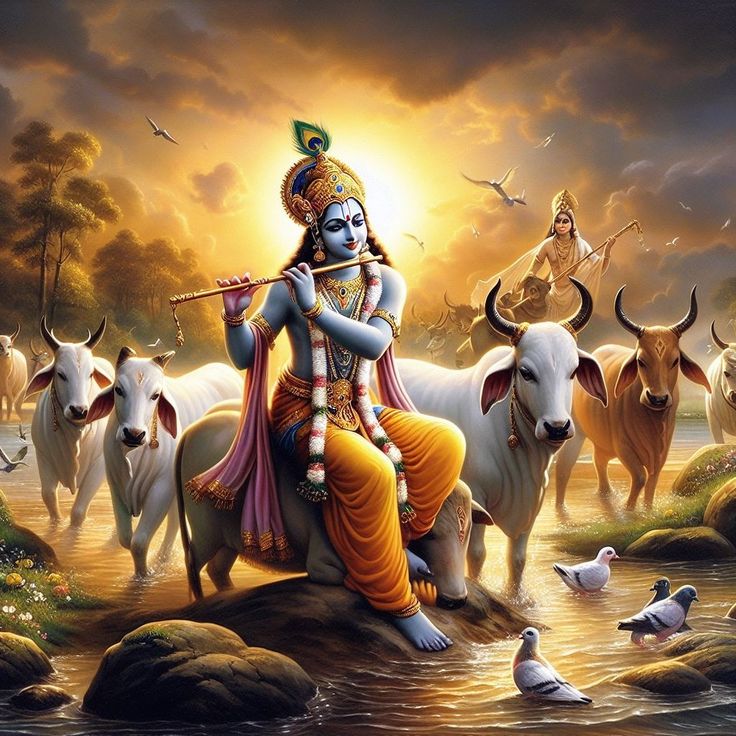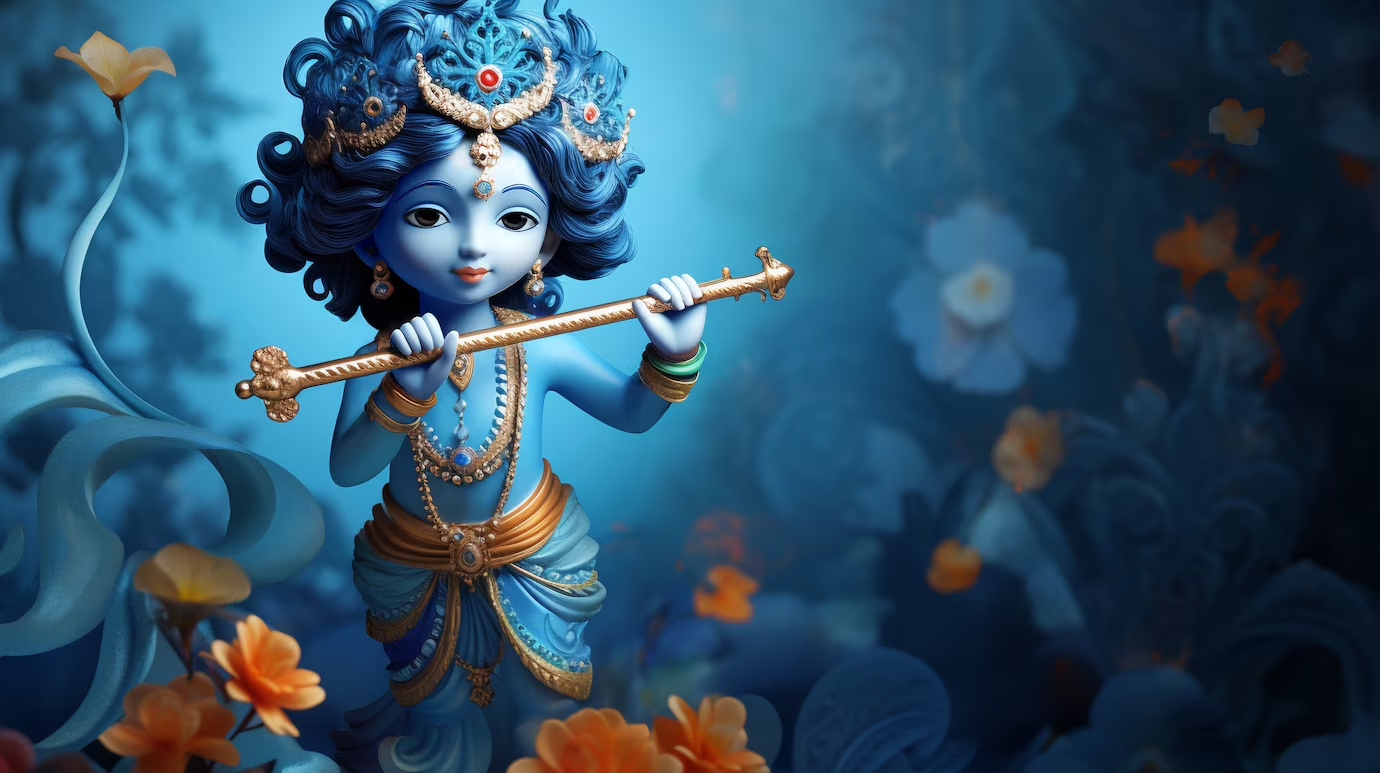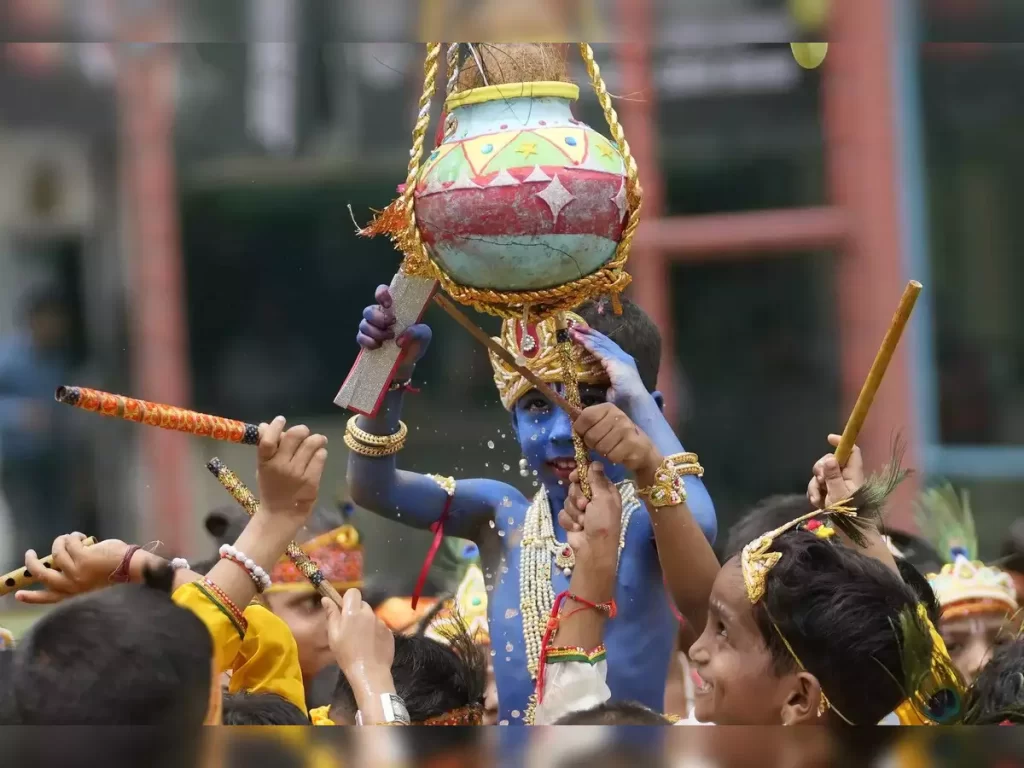Introduction:
The Hindu holiday of Janmashtami, sometimes called Krishna Janmashtami, commemorates the birth of Lord Krishna, the eighth incarnation of Lord Vishnu.. Celebrated on the eighth day (Ashtami) of the dark fortnight of the Hindu month Bhadrapada (August-September), this festival is steeped in rich tradition and spiritual significance.
The number eight holds special importance in Krishna’s life, as he was the eighth child of Devaki and Vasudeva. Born in the darkness of a prison cell in Mathura, Krishna was destined to defeat his tyrannical uncle, Kansa, who had imprisoned his parents and killed all their previous children. To protect the newborn Krishna from Kansa’s wrath, Vasudeva secretly transported him across the stormy Yamuna River to Gokul, where he was raised by Yashoda and Nanda.

The Tradition of Janmashtami
Janmashtami is celebrated with great fervor, especially in Mathura and Vrindavan, the places associated with Krishna’s childhood and youth. Devotees observe a fast and keep a vigil on the eve of Janmashtami, breaking it only at midnight—the hour of Krishna’s birth. The celebration begins with the bathing of Krishna’s idol in water and milk, followed by dressing it in new clothes and offering prayers. Temples and homes are adorned with flowers, leaves, and lights. Special sweets, first offered to the deity, are later distributed as prasada, symbolizing the god’s blessings.
In addition to religious rituals, devotees create elaborate replicas of Mathura, the Yamuna River, and Gokul using small idols of Krishna, other characters from the legend, and scenes from nature. The Dahi Handi event is a popular part of the celebration, where teams of young men form human pyramids to break pots of curd hanging high in the streets, reenacting Krishna’s mischievous childhood pastime of stealing butter.
The Spiritual Significance of Janmashtami
Janmashtami is more than just a celebration of Krishna’s birth; it embodies the spiritual values Krishna represents. Lord Krishna is the embodiment of love, joy, and divine wisdom. His teachings in the Bhagavad Gita, imparted to Arjuna during the Mahabharata war, emphasize the importance of righteousness (dharma), devotion (bhakti), and selfless action (karma). Krishna assures that whenever evil prevails, he will reincarnate to restore peace and dharma.

Celebrating Janmashtami is a way to remember these teachings and strive to embody them in our lives. The festival brings people together, fostering unity, love, and devotion among communities.
Janmashtami Celebrations Across the World
Janmashtami is not only celebrated in India but also around the world, especially in countries with large Hindu populations. In places like Bangladesh, it is even observed as a national holiday. The International Society for Krishna Consciousness (ISKCON) temples worldwide host grand celebrations with devotional singing, dancing, and dramatic reenactments of Krishna’s life.
Decorate for Janmashtami by adorning your home with vibrant flowers, colorful lights, and a decorative swing for the Krishna idol. Enhance the festive spirit with rangoli designs, diyas, and traditional fabrics to create a divine and joyful atmosphere.
In homes and temples, devotees decorate spaces with vibrant flowers, perform Ras Leela (a dramatic portrayal of Krishna’s life), and engage in day-long kirtans (devotional singing). The festival’s joyous and communal atmosphere reflects the essence of Krishna’s teachings—bringing people together in celebration, peace, and harmony.
The Eternal Message of Janmashtami
The story of Krishna’s birth and life is not just a mythological tale but a spiritual allegory. Devaki symbolizes the physical body, and Vasudeva represents the vital life force (prana). When the life force flows through the body, it brings bliss, represented by Krishna. However, this joy is constantly threatened by the ego, symbolized by Kansa. The birth of Krishna within us signifies the awakening of divine love and wisdom, which ultimately dispels the darkness of ignorance and ego.
Celebrating Janmashtami reminds us of the eternal truth that good always triumphs over evil. It encourages us to cultivate the qualities of love, compassion, and righteousness in our lives, just as Krishna did. As we come together to honor Krishna’s birth, we also reaffirm our commitment to these timeless values.
Krishna Janmashtami 2024 Details
| Key Events | |
|---|---|
| Krishna Janmashtami Date | Monday, August 26, 2024 |
| Ashtami Tithi Starts | 03:39 AM on August 26, 2024 |
| Ashtami Tithi Ends | 02:19 AM on August 27, 2024 |
| Rohini Nakshatra Starts | 03:55 PM on August 26, 2024 |
| Rohini Nakshatra Ends | 03:38 PM on August 27, 2024 |
| Shubh Muhurat and Puja Timings | |
|---|---|
| Brahma Muhurta | 04:27 AM to 05:12 AM |
| Abhijit Muhurta | 11:57 AM to 12:48 PM |
| Godhuli Muhurat | 06:49 PM to 07:11 PM |
| Amrit Kalam | 01:36 PM to 03:09 PM |
| Sarvartha Siddhi Yoga | 03:55 PM on August 26 to 05:57 AM on August 27 |
| Pratah Sandhya | 04:50 AM to 05:56 AM |
| Vijaya Muhurta | 02:31 PM to 03:23 PM |
| Sayahna Sandhya | 06:49 PM to 07:56 PM |
| Nishita Muhurta | 12:01 AM to 12:45 AM on August 27, 2024 |
Also Read: Rakhi Decoration Ideas for a Festive Home Celebration
Krishna Janmashtami Puja Vidhi step-by-step
1. Janmashtami Puja Essentials
| Item | Description |
|---|---|
| Swing for Bal Gopal | A decorative swing for the Krishna idol |
| Pooja Chowki | A small platform for performing the puja |
| New Red Cloth for Chowki | Fresh cloth to cover the Chowki |
| Framed Photo of Krishna | Picture of Lord Krishna for worship |
| Panchamrat | A sacred mixture of five ingredients |
| Asana (seat) | A seat for the devotee or idol |
| Ganga Jal (holy water from the Ganges) | Sacred water for ritual purification |
| Ghee Lamp | Lamp made with clarified butter |
| Incense Sticks | Fragrant sticks for offering and purification |
| Chandan (sandalwood paste) | Paste used for applying on the idol |
| Raw Rice | Used in rituals and offerings |
| Tulsi Leaves | Sacred leaves for worship |
| Prasadam (offering) | Food offerings to the deity |
| Clothing for the Krishna Idol | New clothes for dressing the Krishna idol |
| A Garland Made of Flowers | Floral garland for adorning the idol |
2. Wake and Bathe
It is crucial to wake up early on Janmashtami, as the first puja dedicated to Lord Krishna should be conducted in the morning. Begin by bathing the Krishna idol with sacred Ganga Jal. If Ganga Jal is unavailable, you can use regular water. After the bath, dress the idol in new clothes and adorn it with jewelry for the day’s celebrations.
3.Food Offerings
Following the initial puja, offer food to Lord Krishna. The offerings can include milk, fruits, kheera, and other Indian sweets. Place the offerings in a clean bowl next to the Krishna idol. It’s best to use a new bowl and ensure that the offerings are placed on a clean white cloth.
4. Achaman Puja
After the food offerings, perform the Achaman Puja. Light diyas (lamps) and place them around the house. Devotees can sing Krishna aartis and mantras in unison, and some may recite the 108 names of Lord Krishna. During this puja, hold a spoon with Ganga Jal in your left hand and drip the water onto your right hand while chanting “Om Achyutaya Namah.” Sip the water quietly. Repeat the process with the chants “Om Anantaya Namah” and “Om Govindaya Namah.” To conclude the puja, sprinkle water on both hands and dry them.
5. The Milk Bath
Chant the “Brahma Samhita” mantra along with other mantras from the Vedas, Puranas, and Upanishads. As you chant, bathe the Krishna idol with milk, ghee, and flowers. After the milk bath, rinse the idol with water and dry it thoroughly.
6. Post-Bath Puja
Light a diya, apply sandalwood paste to the idol, and start singing the mantra “Shubham Karoti Kalyanam”. . Then, recite “Guru Brahma Guru Vishnu” followed by a Krishna bhajan of your choice. As you recite the mantras, move an incense stick around the idol in a circular motion seven times. Repeat this process with an aarti lamp.
7. Kumkum at Lord Krishna’s Feet
Place kumkum at the feet of Lord Krishna, then touch your forehead with the same kumkum. You can then distribute the prasadana kumkum among the other devotees. The application of kumkum or tilak is believed to purify and sanctify the body. During this phase of the puja vidhi, offer prayers for forgiveness and seek blessings from the Lord.
8. Leave the Offerings for the Lord
After completing the above steps, leave the offerings for Lord Krishna to consume through the night. Alternatively, you can immerse the offerings in flowing water before distributing them among devotees. Before the night ends, recite the “Hare Krishna” or “Om Namo Bhagavate Vasudevaya” to close the Janmashtami puja vidhi.
Importance of Janmashtami
1. Celebration of Divine Birth:
- Significance of Krishna’s Birth: Janmashtami celebrates the birth of Lord Krishna, who is considered the eighth incarnation of Lord Vishnu. Krishna’s birth is symbolic of the victory of good over evil, as he was born to free the world from the tyranny of his uncle, Kansa.
- Spiritual Awakening: The festival serves as a reminder of the divine presence in our lives and the potential for spiritual awakening within each of us. It encourages devotees to seek inner peace, joy, and a connection with the divine.
2. Upholding Dharma:
- Krishna’s Role in the Mahabharata: One of the most important aspects of Krishna’s life is his role in the Mahabharata, where he served as Arjuna’s charioteer and spiritual guide. His teachings in the Bhagavad Gita are considered a guide to righteous living, emphasizing the importance of duty (dharma), devotion (bhakti), and action (karma).
- Symbol of Righteousness: Krishna is seen as the protector of dharma, and his life and teachings inspire people to uphold righteousness and moral values in their daily lives.
3. Social and Cultural Significance:
- Bringing Communities Together: Janmashtami is a festival that unites people across different regions, cultures, and communities. It fosters a sense of togetherness, as people gather in temples, homes, and public spaces to celebrate.
- Promotion of Devotion and Service: The festival is an opportunity for devotees to engage in acts of devotion, such as fasting, singing, and dancing. It also promotes the spirit of selfless service, as devotees distribute prasada (blessed food) and engage in charitable activities.
4. Lessons of Humility and Love:
- Krishna as a Child: The stories of Krishna’s childhood, where he is depicted as a playful and mischievous child, stealing butter and playing with his friends, teach us the value of innocence, humility, and love.
- Symbol of Divine Love: Krishna’s relationship with the gopis (cowherd maidens) and his divine love for Radha are celebrated as symbols of pure and selfless love. These stories inspire devotees to cultivate love and devotion in their own lives.
Also Read: Creative Janmashtami Decoration Ideas for a Beautiful Home Celebration
Story of Janmashtami
1. The Prophecy and Kansa’s Fear:
- The Divine Prophecy: The story of Janmashtami begins with a prophecy that the eighth son of Devaki, the sister of the evil king Kansa, would be the one to end his tyrannical rule. Terrified by this prophecy, Kansa imprisoned Devaki and her husband, Vasudeva, and vowed to kill all their children.
- Kansa’s Cruelty: True to his word, Kansa killed the first seven children of Devaki as soon as they were born. However, when Devaki was pregnant with her eighth child, divine intervention came into play.
2. The Birth of Krishna:
- A Miraculous Night: On the night of Krishna’s birth, a series of miracles occurred. The prison guards fell into a deep sleep, and the chains binding Vasudeva were miraculously unlocked. The gates of the prison opened on their own, allowing Vasudeva to carry the newborn Krishna out.
- Crossing the Yamuna River: Vasudeva carried Krishna in a basket across the stormy Yamuna River to Gokul, where his friend Nanda and his wife Yashoda lived. As he crossed the river, it is said that the waters parted to make way for the divine child.
- A Safe Haven: In Gokul, Krishna was safely placed in the care of Yashoda and Nanda, who raised him as their own son. Meanwhile, Vasudeva returned to the prison with a baby girl (Yogmaya), who was later taken back to Kansa. When Kansa attempted to kill the baby, she transformed into a goddess and warned him that his end was near.
3. Krishna’s Childhood and Early Life:
- A Divine Child: Krishna’s childhood in Gokul and Vrindavan was filled with miraculous events. He is known for his playful mischief, such as stealing butter from the homes of the gopis, and his heroic deeds, like lifting the Govardhan Hill to protect the villagers from a storm sent by Indra, the king of gods.
- Defeating Demons: Even as a child, Krishna displayed divine powers by defeating numerous demons sent by Kansa to kill him. His victories over these evil forces further solidified his role as the protector of the righteous and the destroyer of evil.

4. The Return to Mathura and Kansa’s Defeat:
- Journey to Mathura: As Krishna grew older, he was eventually summoned to Mathura by Kansa, who was unaware that his end was near. Krishna and his brother Balarama traveled to Mathura, where they were welcomed as honored guests.
- The Final Battle: In a grand wrestling match organized by Kansa, Krishna and Balarama defeated the mighty wrestlers of Mathura. Finally, Krishna confronted Kansa in his court and killed him, fulfilling the prophecy and restoring peace to the kingdom.
5. Krishna’s Legacy:
- A Life of Devotion and Wisdom: Krishna’s life is a blend of playful mischief, deep wisdom, and unwavering devotion. His teachings in the Bhagavad Gita remain a cornerstone of Hindu philosophy, offering guidance on living a life of righteousness, love, and spiritual fulfillment.
- Eternal Relevance: The story of Krishna’s birth and life continues to inspire millions of devotees around the world. Janmashtami is a time to reflect on these teachings, celebrate the divine presence in our lives, and renew our commitment to living a life of virtue and devotion.
Conclusion:
Janmashtami is a vibrant and spiritually enriching festival that celebrates the birth of Lord Krishna, the eighth incarnation of Lord Vishnu. Marked by various rituals and joyous activities, this festival not only commemorates Krishna’s divine birth but also embodies his teachings of righteousness, love, and devotion. Through the meticulous observance of puja rituals, devotees reaffirm their commitment to living a life of virtue and spiritual awakening. As the festival brings together communities in celebration, it serves as a reminder of the eternal message of Krishna—good always triumphs over evil, and divine love prevails over ignorance.
Frequently Asked Questions:
Janmashtami is celebrated on the eighth day (Ashtami) of the dark fortnight in the Hindu month of Bhadrapada, which usually falls in August or September.
Key rituals include bathing the Krishna idol with Ganga Jal, offering food items (bhog), performing Achaman Puja, and celebrating with traditional events like Dahi Handi.
Fasting on Janmashtami is a way for devotees to express their devotion and penance. The fast is typically broken at midnight, coinciding with Krishna’s birth.
Dahi Handi reenacts Krishna’s childhood pastime of stealing butter. Teams of young men form human pyramids to break clay pots filled with curd, symbolizing Krishna’s playful spirit and his love for butter.
Prepare by gathering puja essentials like a swing for the idol, new clothes, a framed photo of Krishna, and offerings such as milk, fruits, and sweets. Perform the rituals early in the morning and decorate your home with flowers and lights.
Suggested Articles:
Creative Janmashtami Decoration Ideas for a Beautiful Home Celebration
Rakhi Decoration Ideas for a Festive Home Celebration







































